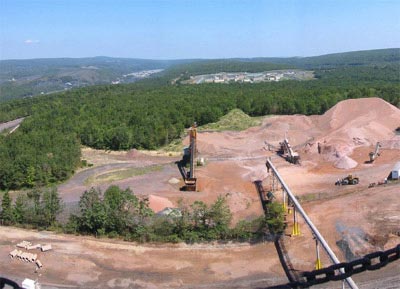Reply Briefs in Excelsior Mesaba docket
January 21st, 2007

Yes, the Reply Briefs for Excelsior’s Meaba coal gasification project PPA at the PUC have flown around the ether, and here they are:
mncoalgasplant.com Reply Brief
Missives on Big Stone II
January 20th, 2007

Some interesting things on the wire about Big Stone. You remember Big Stone, don’t you, that big ol’ coal plant just on the other side of the border supposedly to serve some MN coops and municipal utilities (so prove to me, coops and munis, that this plant will even get to your service territory, that it will fulfill your particularized need):
Letter from Mark Rolfes – semi-annual Report to SD PUC
Revised Plant Water Mass Balance
Revised Plant Site DrawingÂ
For all the BS Documents, CLICK HERE!Â
The letter from Mark Rolfes is by far the most interesting one. It starts out with a big bang — he says that many of the contracts have lapsed, and must be “refreshed.” Contracts on a few little things like boiler, turbine, those really pricey things, and this is the project that had said last summer that they’d experienced a 60% cost increase. And so now how much more will it go up? And will they even be able to get contracts — and if so, delivery when? They’ve pushed back the construction start date, they’ve pushed back the completion date, and their credit rating took a hit recently. I’m starting to think, hope, that maybe, like Excelsior’s Mesaba coal gasification project, this just won’t happen!
DOE says sequestration ain’t a happen’ thang!
January 19th, 2007

Above? That’s a coal agitator! Separates coal from rock by agitating…
Hot off the press, LAST MONTH’S news – the DOE admits that sequestration just isn’t going to happen for a while. About time!
Supplement to DOE’s DEIS for Gilberton PA coal to liquid fuel project
Comments taken through February 27, 2007:
Janice L Bell
NEPA Document Mgr.
US DOE – NETL
626 Cochrans Mill Road
P.O. Box 10940
Pittsburgh, PA 15236-0949412-386-4512
412-386-4806 faxjbell@netl.doe.gov
Got this just as we were shipping out Reply Briefs in the Mesaba Project. Too bad this isn’t in the record, eh?
Briefs will be posted soon.

Great Plains Institute – is Joyce getting their $$ worth?
January 18th, 2007
Great Plains Instutute, no doubt working on that Joyce Foundation funded promotion of IGCC in the midwest ($437,500), is doing the Dog & Pony show about their “plan.” They know the cost figures are way off but don’t seem to think that’s a problem and don’t seem to want to update them to reflect what we’ve learned from the Mesaba Project. Earth to Great Plains, IGCC costs a lot more than what you say it does, and even AEP recognizes that and is taking their IGCC project back to the calculator. Great Plains, you’re not going to get away with this level of knowing misrepresentation!
Despite inaccurate information, Great Plains Institute is holding “Town Hall” meetings in a few states, ostensibly to get public intput into their plan, and last night’s meeting was co-sponsored by the Minnesota Project. We’ll see just how far that public input goes! To get information about these Town Hall meetings, first go to their Regional Roadmap site, then to find out more, and it’s not written clearly, we next go to “www.poweringtheplains.org” and then go to right side and click on “Attend Town Hall Meeting closest to you.” which doesn’t have a separate link. And the Coal Gasification Work Group turns into the Coal Work Group on the next screen… Look who’s a part of this: Participants
Here’s a photo from the IGCC Junket — who paid for this trip?
WILL SOMEONE PLEASE EXPLAIN TO ME WHY THEY DIDN’T GO TO INDIANA’S WABASH RIVER TO SEE REALITIES OF IGCC?
The fact of the promotional Joyce grant was not disclosed by Great Plains, nor has it been publicly acknowledged by the parties participating. Oh well, one more thing on the “To Do” list, eh?
Joyce Foundation Funding Announcement $3 million for IGCC promotion
Here’s what Great Plains got:
Great Plains Institute for Sustainable Development
Minneapolis, MN $437,500
To support the efforts of its Coal Gasification Working Group. (21 mos.)
Here are “their” plans:
Powering the Plains – Great Plains Institute Roadmap – Executive Summary
After a quality meal, thank you, Joyce!, we were then to go to tables designated as a particular area of interest. I picked the Coal group. Then we were to review their “Summary of Draft of Roadmap” and comment on it. So what I did yesterday was introduce a little bit of reality into their pipedreams of IGCC, giving them my handouts ahead of time so they’d know. Much of the cost information on Mesaba has been available for months, and other information is available on the web, it’s not hard to find, so there’s no excuse for using such outdated cost estimates. None of this “apples to apples” nonsense (that tired Excelsior mantra) about using info all from the same source, it’s outdated, there hasn’t been an IGCC proposal through a public docket since Wabash River, so you’d better be paying attention to this and use the more accurate information that’s there.
There are two big falsities in the Great Plains information and plan. One is the presumption of CO2 capture and sequestration, which is a pipedream and for which the industry has only started, STARTED to address the costs of capture, to the plant gate, and sequestration on a commercial level is way off, if ever, both in timeline and geography. Second, the costs used by Great Plains, on which this “plan” is based, are off — take their number of $1,402/kW and multiply by 2.5 and you’re just a bit shy of the $3,593/kW cost of Mesaba (and we know it’s really a lot more). 2.5 times? There’s no excuse for that, it’s not justified.
Here is a comparison of the area they’re targeting for promotion of IGCC with the areas for potential sequestration:
And then there’s costs – they are SO obscenely far off in their numbers. They have a /MW cost of $1,402,000/MW when it’s $3,593,000/MW according to the DOE. Their Efficiency numbers are way off too, demonstrated in the MPCA analysis of Mesaba — GPISD says 41%, and MPCA says 36%. Cost, well, they say busbar cost is $0.0276-0.0329/kW and $27.6-$32.9/MW, when according to Amit’s Surebuttal, minus sequestration cost, it’s $0.102-$0.187/kW or $102.33-132.05/MW. Do ya think that merits correction? We’ll see… The tables in the pdf below are Table 1 and Table 10 from their “Pathways to a Reduced Carbon Energy System for the Upper Midwest (DRAFT) that’s above.
GPISD Grossly Erroneous Numbers
DOE Financial Assistance Agreement, p. 1 ($2,155,680,783/600,000= installed cost of $3,593/kW)
Don’t worry, Great Plains, you’re not the only ones way off base here, your other Joyce promotional compadres have the same problem, have the same corrections to make, and the light is on you all. Here’s another example, NRDC’s power point with costs of IGCC that aren’t even close, compare their costs with the Mesaba costs:
Bottom line? It’s just not right to be misrepresenting like this and it’s just not right to be basing “policy” on this, and it’s got to stop.
Here are the MPCA reports that show IGCC’s not all it’s cracked up to be:
Excelsior Surrebuttal to MPCA Emissions Comparison and Jackson Testimony
And what do you think the Joyce ancestors think of an IGCC plant just a stone’s throw east of the Joyce Estate? Here’s info about the Joyce Estate that I got when I went to check it out last summer: Joyce Estate – Trout Lake
The next meeting is in Eau Claire, no RSVP required:
Thursday, January 25
6:00 – 8:00 p.m.
Chippewa Valley Technical College
Gateway Center
2320 Alpine Road
Eau Claire, WI
If questions, it says to contact Brendan Jordan: 612-278-7152 or Bjordan[at]gpisd.net
Monticello’s not the only one!
January 18th, 2007

There’s more — there are other plants like Monticello, they could have the same problem of 35,000 pound pieces of the plant breaking loose and falling…
Where is that potassium iodide?
Monticello accident prompts alert to other nuclear plants
Four plants, in New York, New Jersey, Vermont and Massachusetts, are similar in age and design to the one idled in Minnesota.
By Tom Meersman, Star Tribune
Last update: January 17, 2007 â?? 9:24 PMFederal officials have alerted the owners of four nuclear power plants about a potential safety problem that caused an automatic shutdown last week at Xcel Energy’s Monticello nuclear plant in Minnesota.
“Typically when there’s a problem at one plant, we look to see if any aspects have the potential of applying to other plants,” said Jan Strasma, spokesman for the Nuclear Regulatory Commission. “It’s a precautionary or prudent notification.”
At the time of the Jan. 10 incident, Monticello had been operating for a record 637 consecutive days, 161 days longer than ever before, according to Xcel officials. Typically nuclear plants shut down for refueling every 18 to 20 months, and are out of service for four to five weeks, during which utilities also schedule major maintenance and inspections.
The Monticello plant remained closed Wednesday, one week after a 35,000-pound control box broke loose from its support beams and fell about a foot onto a large pipe carrying radioactive steam. The pipe did not rupture or leak.
Strasma said his agency has notified managers of four Northeast plants similar to Monticello in age, design, and layout about the incident in Minnesota. The plants are Vermont Yankee, Oyster Creek in New Jersey, Nine Mile Point in New York and Pilgrim in Massachusetts, he said.
The Monticello plant, about 45 miles northwest of the Twin Cities, began operating in 1970.
Two months ago Xcel received federal permission to extend the plant’s license for 20 years after its current license expires in 2010. State regulators have also given the utility permission to expand radioactive-waste storage in casks outside the plant, but the Minnesota Legislature has the option to review that decision.
Suspicion has focused on the control box’s welds, which may have been weakened by vibrations.
Charles Bomberger, Xcel’s general manager for nuclear asset management, said the steam pipe struck by the falling box didn’t rupture. He said steam pipes are designed, anchored and tensioned to withstand much more severe shocks and stresses, including earthquakes.
Even if the pipe had leaked, only a small amount of steam would have been released and isolated within the plant, Bomberger said.
“I don’t want to sugarcoat it; this was a significant problem,” Bomberger said. “It’s got the full attention of Xcel.” The utility will fully evaluate the cause of the problem, repair it, check for other possible damage and report everything to federal authorities, he said.
“We anticipate a relatively short-term outage that will be measured in days, not weeks,” he said. “I think we have our arms around what caused it.”
George Crocker, a nuclear safety advocate in Lake Elmo, said the incident should be a warning for several reasons.
“Market forces that push nuclear plants to the limit, coupled with aging issues, coupled with the lack of understanding about how these components and materials perform over time as they’re subjected thermally and radiologically — all of these factors are increasing the likelihood that a really unforgiving event will occur,” said Crocker, executive director of the North American Water Office.
The group is a nonprofit organization that has raised concerns about nuclear problems for more than two decades and also works on renewable-energy policy.
Bomberger rejected the notion that Monticello has been pushed to the limit, or that it’s risky. Nuclear plants have multiple backup systems to provide layers of safety, he said. Maintenance occurs on many parts and systems even while the plant is at full power production, he said enabling Monticello to run for longer periods between shutdowns.
Bomberger said that setting records for consecutive days of operation shows that Monticello is being operated more efficiently, and that equipment failure and other problems are more likely when a plant is stopped and started than when it’s running at a constant rate.
“I firmly do not believe that just because we have a long continuous run that we are running the equipment harder and that’s it’s going to wear out faster,” he said.
Tom Meersman â?¢ 612 673-7388 â?¢ meersman@startribune.com
©2007 Star Tribune. All rights reserved.